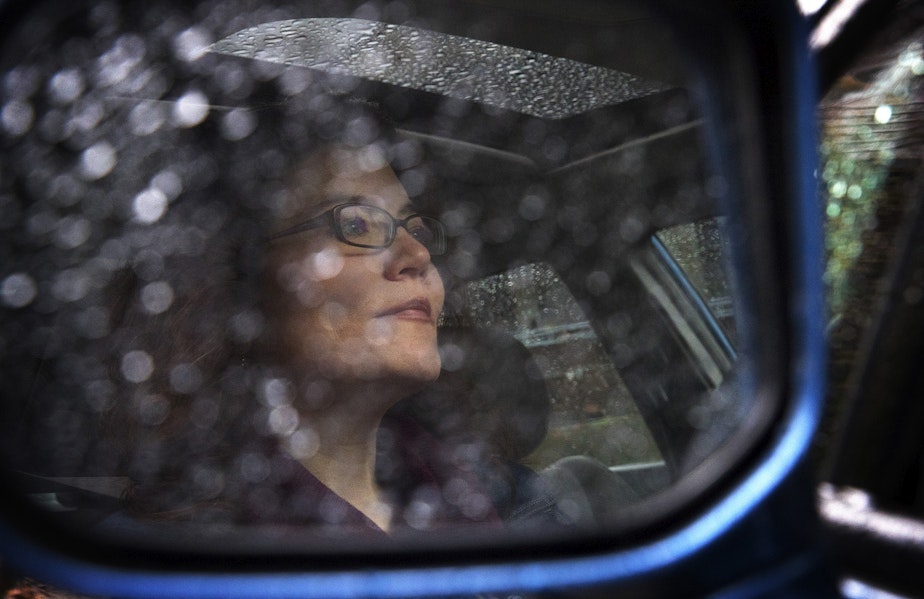Does this photo make you nervous? You wouldn't be alone

Tunnels make people anxious. Up to 15 percent of people, in fact.
We learned this while researching a question from listener Sara Norris, who wondered why drivers seem to slow down when they enter tunnels.
Seattle’s new waterfront tunnel opens in February (three weeks after the Alaskan Way Viaduct closes for good), so we decided to investigate.
Turns out, people do drive more slowly in tunnels.
Part of that has to do with perception, said psychologist Roberta Klatzky of Carnegie Mellon University. She said tunnels can be disorienting, making it seem you are driving faster than you are.
Want to hear the SoundQs podcast on traffic phobias? Click here
There's also the fear factor.
In Europe, civil engineers try to ease people's tunnel fears with progressive lighting and imagery along tunnel walls. Susanne Pedersen, an engineer based in Copenhagen, works on the Fehmarn Belt Tunnel, an undersea tunnel that will connect Denmark and Germany.
Sponsored
The fluorescent lighting in tunnels can often feel repetitive, like you’re stuck in some noir film, but lights in the Fehmarn Belt Tunnel will be colored and change, “so it will show you how far you are on your journey,” Pedersen said.
That sense of movement is supposed to ease a driver's tunnel anxieties.
The undersea Fehmarn tunnel will include images of migrating birds along the side walls, to represent the live birds that travel above ground traveling along same route. The tunnel will also have an emergency lane that, even though expensive to include, is expected to reassure drivers.
Here in Seattle, the waterfront tunnel designers didn’t plan for anxiety, per se, said spokesperson Laura Newborn. But “there are a lot of things that make this tunnel feel more spacious.”
The tunnel is spacious, with an 8-foot wide emergency shoulder, high ceilings, and lighting at the entrances and exits that adjusts to outside conditions (no more spooky sepia tone like as with the Battery Street Tunnel). There's also an emergency exit pathway that runs the length of the tunnel with a separate air system should something bad happen.
Sponsored
Pedersen, the civil engineer from Copenhagen, said the features on the Seattle tunnel could help.
But for the one to three percent of people with acute traffic phobias, Pedersen recommended professional help.
Jenny d'Armand, a Seattle singer and voice-over artist, said that's her, and she is getting help.
“For me, the panic is being trapped," she said. "If I’m on a bridge, if I'm on a plane, if I'm in a tunnel, the feeling is: I'm stuck here and there's no way out."
Bad traffic doesn't help.
Sponsored

Jenny d’Armand doesn’t like tunnels, but her bigger problem is with bridges. She once turned down a job because it would have required taking a bridge.
She’s seeing Stacy Shaw Welch, a psychologist in Seattle, who provides exposure therapy to her patients.
The idea is to face one's fears gradually. Jenny d’Armand started out in an office, then sat in a parked car, and then was able to drive alone across the Tacoma Narrows Bridge.
Sponsored
Dr. Jim Basinski, a psychiatrist who practices psychodynamic therapy, said tunnel phobia might be a window into the unconscious mind, where “the tunnel represents a metaphor for some difficult memory or emotion that they find themselves avoiding.” In his practice, talk therapy is part of the cure.
But what if you don't suffer from tunnel or other traffic phobias, and just hate bad traffic so much that it makes you rage?
Nearly 80 percent of people experience some form of road rage, and in 2015, about 6 million people admitted to bumping or ramming another vehicle on purpose, according to surveys by the AAA's Foundation for Traffic Safety.
If that's you, consider working from home starting on January 11, when the viaduct comes down, before the tunnel is open.




